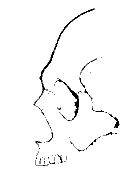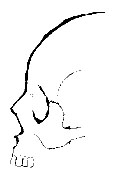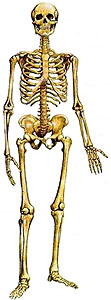GID.info |
||||||||||||
| Gender
Identity Disorder Information |
||||||||||||
Dysmorphology Dysmorphology Definition: The study of morphological developmental abnormalities as seen in many syndromes of genetic or environmental origin. At first glance "Dysmorphology" might seem like a modern descendant of Phrenology (the quack practice of studying the bumps on someone's head). Or worse yet, an extension of the eugenics "measuring" done by Nazi doctors during WWII to either prove someone was Aryan or too Jewish. Luckily, Dysmorphology is nothing so ominous. There is no "normal" measure of human features, per se, however there are averages and common proportions. Unless a person's size is seriously out of the normal range (as in Gigantism or Dwarfism), it is "proportion" that is more important. Dysmorphology draws on both mathematical models of proportioning as well as statistical data of what proportions are common among the general population, as well as within specific age groups, ethnic groups, or within one gender. A person is only considered "Dysmorphic" if their proportions and/or overall measurements are quite obviously out of the expected range. Terms used to describe defects:
This deals with the PHYSICAL person and is unrelated to Body Dysmorphic Disorder (BDD) which is a PSYCHOLOGICAL problem where the person believes his or her body is deformed in the absence of any medical or statistical evidence that it is. There are standard proportions/ratios that apply to about 70% of the population. People who have body ratios within those parameters don't draw any attention due to their shape or size. The ratios, though, are split primarily along gender lines. Human beings notice someone's sex before they notice anything else about the person, so if any proportions are in the overlap area between male and female or out of range for a person's birth sex, they are either "ambiguous" (i.e., "androgynous") or perceived as the opposite of their birth sex. In general it is not the actual MEASURE that matters, it is how each part is proportionally related to the rest of the parts. To see how the body ratios work, try this Body Ratio Calculator - also calculates other proportions and ideal weight. In addition to simple measurements and statistical average ratios, there are also generalized proportions. The best known and most used are probably the "Artist's Proportions" of figure drawing. Dysmorphology & Artistic Proportions
These methods of proportioning were based on keen observation and an artist's eye for detail. They allow an artist to draw a proportionally correct figure of a human being that isn't actually a portrait of any actual person. The form that results is just generalized enough that it fits a large portion of the population with only minor adjustments. If major adjustments are required, the person would be considered "deformed" by most people. However, one must remember that the proportions are centered on the ancient Greek concepts of "perfection."
Dysmorphology & The Face
The basic Archetypal Mask is essentially that of a female face. Since the basis for our species is female, even genetic males have many feminine features in their faces and feminine features in a male face can also be desirable in that they are perceived as being more caring and friendly. However, there are differences between the Archetypal Mask and what are considered the "handsomest males." There are also slight variations between the ethnic groups for Caucasian, Asian, and African.
Figure A Shows the outline of a typical male skull contour. Notice the prominent brow ridge and large nasal cavity. The forehead also has a much more vertical slope to it. Figure B shows a typical female skull contour. Note the smaller nasal cavity, as well as the curvature just above the teeth. There is also no brow ridge and the forehead is much more curvilinear.
The features of the male skull are the result of stimulation from male hormones and prohormones (like Human Growth Hormone, or HGH). These actually CAUSE the nasal cavity to increase in size, the brow ridge to form, and even widen the lower jaw or add a protuberance to the point of the chin. Inadequate amounts of these hormones during puberty prevent such bone growth stimulation. This change to bone structure generally occurs during the teenage years of puberty, and is set by the time a person is 18 years old. Dysmorphology & The Skeleton
The opening in the pelvis on a man is narrow and heart shaped (above left) and the opening for a woman is wide and oval shaped (above right). The angle of the pubic arch, called the "sub pubic angle" is also narrow for a man at less than 90 degrees. For a woman's pelvis this angle is usually wider than 90 degrees. Also note how the Iliac Crest of the male pelvis is deep and funnel shaped, while it is broad and shallow, flaring outward for the woman. Most of these differences in bone structure are caused by hormone levels during puberty. If the hormone levels are interrupted or abnormal the bones will not develop normally. Once a person has reached adulthood the bones usually stop this sex biased differentiation. There are now surgical procedures for altering the contours of facial bones, sometimes called Facial Feminization Surgery, which requires a surgeon literally grind off the bone growth caused by male puberturial virilization. Surgical procedures for altering other sex differentiated bone structures have not been developed. In other words, a male pelvis cannot be reshaped into a female pelvis, shoulders cannot be un-broadened, hand and foot size cannot be reduced. The Argument for Early Intervention in Cases of GID Because most of these virilizations occur during puberty and are "set in bone" by adulthood, the best way to affect the shaping of skeletal structure is to do so during puberty when the skeleton is still "plastic." Many people with Gender Identity Disorders realize before or during puberty the true nature of their gender identities. For male-to-female gender dysphorics the virilizations of male puberty are often traumatic in and of themselves. Early diagnosis of GID allows doctors to intervene and, at least, arrest the processes of skeletal masculinization and, at best, encourage typical female development.
|
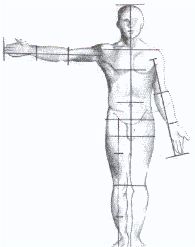 During
the Renaissance Period in Europe there was a resurgence in the Classical
Realism of the Golden Age of Greece and Rome. The concepts that combined
a mathematical discipline with artistic composition were rediscovered
and advanced. The so-called "Golden Rule" for proportion and
perspective. Leonardo DaVinci wrote much in his notebooks on human anatomy
and described the method of proportioning a human figure when drawing
from life. This was accomplished by subdividing the body into the component
parts and using, say, the head as a rule of measure for other parts
of the body. For example, the standing height is eight heads high. The
shoulders are 3 heads wide, and so on.
During
the Renaissance Period in Europe there was a resurgence in the Classical
Realism of the Golden Age of Greece and Rome. The concepts that combined
a mathematical discipline with artistic composition were rediscovered
and advanced. The so-called "Golden Rule" for proportion and
perspective. Leonardo DaVinci wrote much in his notebooks on human anatomy
and described the method of proportioning a human figure when drawing
from life. This was accomplished by subdividing the body into the component
parts and using, say, the head as a rule of measure for other parts
of the body. For example, the standing height is eight heads high. The
shoulders are 3 heads wide, and so on.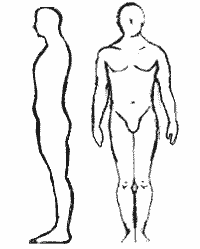

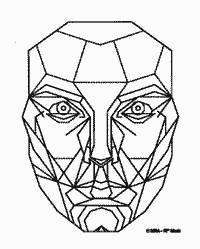 It
turns out that the core mathematics that govern proportion, composition,
and perspective in art are rooted in pi. This "magic number"
appears in virtually everything in nature and is the foundation for
what we perceive as symmetry and even beauty. Research has been done
to try an quantify what "beautiful" is. After all, what makes
some of the world's celebrated "beautiful people" beautiful?
What parameter should guide facial reconstructive surgeons or plastic
surgeons trying to make a person more attractive? As "beauty"
is a multi-billion dollar industry, there was plenty of money and interest
in finding those answers. Biologists and Anthropologists were also interested
in the answer. Most animals "advertise" their qualities as
a potential mate in some fashion, often visual, so what "clues"
were there in human appearance that are perceived as desirable from
a distance? Ultimately in answering that question the Archetypal Mask
was developed. This is a generalized set of geometric shapes that comprise
the features of the human face. Moreover, they are the mathematically
balanced placements. Much like the statistics of the body ratios, there
are "ranges" within the mask for the position of eyebrows
or lips or the jaw line, but the closer a persons contours match those
of the mask, the more "attractive" and "desirable"
they are. More can be found out about these masks with the developer
It
turns out that the core mathematics that govern proportion, composition,
and perspective in art are rooted in pi. This "magic number"
appears in virtually everything in nature and is the foundation for
what we perceive as symmetry and even beauty. Research has been done
to try an quantify what "beautiful" is. After all, what makes
some of the world's celebrated "beautiful people" beautiful?
What parameter should guide facial reconstructive surgeons or plastic
surgeons trying to make a person more attractive? As "beauty"
is a multi-billion dollar industry, there was plenty of money and interest
in finding those answers. Biologists and Anthropologists were also interested
in the answer. Most animals "advertise" their qualities as
a potential mate in some fashion, often visual, so what "clues"
were there in human appearance that are perceived as desirable from
a distance? Ultimately in answering that question the Archetypal Mask
was developed. This is a generalized set of geometric shapes that comprise
the features of the human face. Moreover, they are the mathematically
balanced placements. Much like the statistics of the body ratios, there
are "ranges" within the mask for the position of eyebrows
or lips or the jaw line, but the closer a persons contours match those
of the mask, the more "attractive" and "desirable"
they are. More can be found out about these masks with the developer
